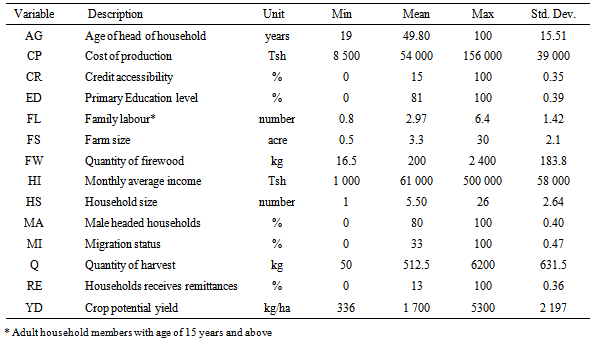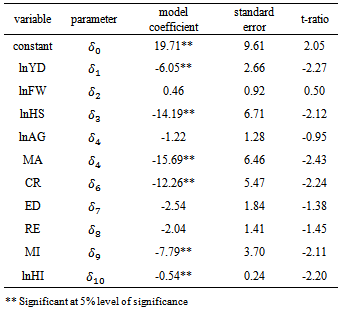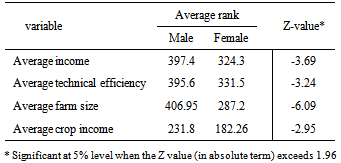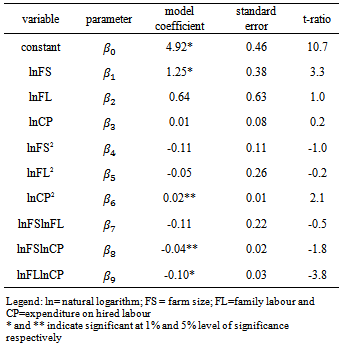-
Paper Information
- Previous Paper
- Paper Submission
-
Journal Information
- About This Journal
- Editorial Board
- Current Issue
- Archive
- Author Guidelines
- Contact Us
Resources and Environment
p-ISSN: 2163-2618 e-ISSN: 2163-2634
2013; 3(6): 194-203
doi:10.5923/j.re.20130306.04
Technical Efficiency as a Sustainability Indicator in Continuum of Integrated Natural Resources Management
Aloyce S. Hepelwa
Department of Economics, University of Dar es Salaam, Dar es Salaam, +255, Tanzania
Correspondence to: Aloyce S. Hepelwa, Department of Economics, University of Dar es Salaam, Dar es Salaam, +255, Tanzania.
| Email: |  |
Copyright © 2012 Scientific & Academic Publishing. All Rights Reserved.
To understand variables that link the welfare, livelihood and the watershed is crucial when instituting the integrated watershed management. This requires having indicators to show changes of the condition of the welfare, livelihoods and watershed resources. However, the combination of livelihoods and welfare of the local communities who depend largely on watershed resources for income, food, energy and shelter have not been adequately considered elsewhere. This results to the imbalance between the human development and the conservation priorities when implementing watershed management policies. The aim of this paper is to present the technical efficiency indicator (TEI) constructed from socioeconomic and watershed related variables. The stochastic frontier analysis (SFA) is employed to construct the TEI. The novelty in the current study is its ability to combine socioeconomic and biophysical information to obtain a sustainability indicator of both the natural resource supporting people’s livelihoods and the welfare of people. The construction of TEI fills the knowledge gap on how to achieve the mutual balance between human development and conservation objectives in the natural resource management arena. Study findings are that there is significant household dependence on the watershed resources. This implies that watershed resources have a greater role to play on the welfare of the communities due to existing direct relationship between crop cultivation and the watershed environment. Therefore there is a need to take into account the sustainability of the watershed resources when setting up development policy in the study area.
Keywords: Integrated Watershed Management, Sustainability Indicator, Technical Efficiency
Cite this paper: Aloyce S. Hepelwa, Technical Efficiency as a Sustainability Indicator in Continuum of Integrated Natural Resources Management, Resources and Environment, Vol. 3 No. 6, 2013, pp. 194-203. doi: 10.5923/j.re.20130306.04.
Article Outline
1. Introduction
- Sustainability is taken to mean that all resources are used efficiently both within and between generations and that the productive base of society is more or less preserved overtime[1]. In Tanzania watershed resources are found to support directly welfare of most households in the area and or adjacent by means of food, construction materials, medicines, firewood, charcoal and water[2]. The watershed also supports households’ wealth in the form of asset such as livestock. Given the higher value to and the dependence of local communities on the watershed resources, it means that conservation of watershed resources requires additional policies to prevent an increase of poverty in the country. Thus the implementation of the integrated watershed management is paramount. The concept of the integrated watershed management emerged in the 1970’s following the warning of the scientific community on the state of the environment on the earth. As one of the first events that emphasized the environment management in the framework of development, the UN Conference on Human Environment of 1972 can be mentioned. The conference urged the governments to pay attention on conservation of natural resources while pursuing their development goals. However, the implementation of conservation and development issues remained as a separate goal for a long time by many governments. The Brundtland report defines sustainable development as the development that meets the needs of the current generation without compromising the ability of the future generation to meet their needs. The report marked the start of the integration of both the development goals and the conservation goals in the planning.In 1992, at the occasion of the Rio conference of the WCED, the Agenda 21 was formulated. The key message of the Agenda was the establishment of a framework for the integrated watershed management. The Agenda also included guidelines for the promotion of alternative income generating activities. The Agenda 21 played an important role for the integration of conservation and development goals. It was indeed the first time that the views of economists and social scientist were incorporated in watershed management[3]. Today, it is considered a basic human responsibility to ensure that both natural and human systems are sustained in healthy condition for the sake of the earth and people. Vishnudas et al[4] point out that, for the watershed to be sustainable, land, forest and agriculture must be sustainable first. However, the bench mark or indicators to guide of the status of the sustainable development of which both the natural resources and welfare of the people who are depending of these resources is lacking. The rest of the paper is organized in four sections. After introduction, the second part presents materials and methods, the third section details empirical literature on the technical efficiency and sustainability indicators. Section four presents the theoretical framework followed by the methodology. The stochastic frontier methods are discussed. This is followed by the discussion of the study results in section five. Lastly are the concluding remarks and policy implications in section six.
2. Materials and Methods
2.1. Location and Physical Characteristics of the Study Area
- The area for this study is the Sigi catchment, with a total area of 1100 km2. It is located between latitude 4o 80' and 5o 26' S and longitude 38o 58' and 39o 10' E in Tanga region, the North Eastern part of Tanzania (Figure 1). The basin is situated on the eastern slopes of the of the East Usambara mountain block of the Eastern Arc Mountain forests, at altitudes between 2 and 1200m above mean sea level. The basin comprises most of the forests of the East Usambara Mountain. These forests occupy most of the upstream of the basin.
 | Figure 1. Location of the study area in Tanzania |
 | Figure 2. Sigi catchment, topography, river networks and stations |
2.2. Rainfall and Temperature
- The area has a bi – modal rainfall pattern with two rain seasons. The long rain period is March – May and the short rain period is October – December. For the period between 1995 and 2005, the monthly average rainfall stood between 30 and 174 mm (Figure 3). On the other hand, the maximum temperature ranges between 28℃ and 35℃ and the minimum temperature between 17℃ and 23℃ (Figure 4).
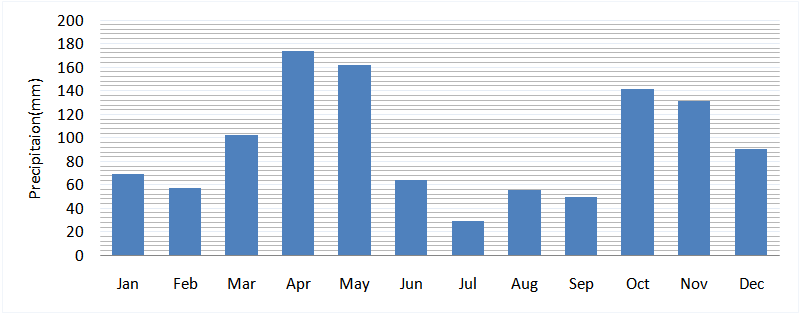 | Figure 3. Rainfall distribution for 1995 – 2005 at Lanzoni weather station |
 | Figure 4. Temperature distribution 1995 – 2005 |
3. Relevant Literature on Technical Efficiency and Sustainability Indicators
- An indicator is something that helps to understand the past, present and future state of resource in question. Identifying and developing environmental sustainability indicators have been recognized as the cornerstone of the UN-World Water Assessment Programme. The early efforts of UNESCO’s International Hydrological Decade, subsequent International Hydrology Programme (IHP) phases, FAO, IAEA and UNEP as well as professional organizations have produced several important methodological guidelines toward indicator development. It is argued that, most indicator initiatives aimed at providing information at a national level for state-of-the-environment reporting[5, 6, 7, 8] or for answering specific policy questions at national and international levels[9, 10, 11]. Environmental sustainability is a relatively new phenomenon in comparison to indicators of economic and social aspects[12]. The central idea with the environmental sustainability indicators is to ensure meeting the current human needs without undermining the capacity of the environment to provide for those needs over the long term[13]. The current water resources sustainability indicators include the water poverty index (WPI) by Sullivan[14], the Canadian Water Sustainability Index (CWSI) by Policy Research Initiative[15] and the Watershed Sustainability Index (WSI) by Chaves and Alipaz[16]. WSI based on UNESCO framework called HELP (Hydrology, Environment, Life and Policy). WSI is a watershed specific index that takes into account cause-effect relationships and considers policy responses implemented in a given period as part of the basin’s sustainability. The WSI includes the extent of forest cover in the watershed. Policy Research Initiative[15] states that, the catchment is sustainable when are covered by about 40% of natural vegetation. A catchment is also said to be sustainable if there is 20% or greater improvement in catchment conservation. The efficiency in production has been examined for more than 60 years[16, 17]. The technical efficiency (TE) is defined as the ratio of the firm or the farmer actual production to the optimal output. The TE reflects the ability of the producer to obtain maximum outputs from a given set of inputs. Therefore, the producer is said to be technically efficient when the actual output is equal to the optimal output and the same producer is said to be inefficient when the actual production is less than optimal output or the frontier output[17]. For the given production processes, technical efficiency would be measured theoretically within the range
 . The literature proposes two alternative approaches for the estimation of TE. The first approach is the SFA, the parametric Stochastic Frontier Analysis[18, 19, 20, 21, 22, 23]). The second approach is DEA, the non-parametric Data Envelopment Analysis[24]. It is concluded from the literature that sustainability of water resources can be effectively achieved as the poverty within the community decreases. Natural assets such as land, forests and water have linkage between watershed management and livelihood, thus, watershed management that focuses on natural resources alone has a limited impact on livelihood and poverty[2]. This conclusion however does not put out clear that the established relationships are location specific and cannot be used to generalize the situation in other areas. This therefore calls for a site specific study to reveal the actual condition of the natural environment and livelihoods issues in order to ascertain the clear link between watershed resources and the welfare condition of the local community.
. The literature proposes two alternative approaches for the estimation of TE. The first approach is the SFA, the parametric Stochastic Frontier Analysis[18, 19, 20, 21, 22, 23]). The second approach is DEA, the non-parametric Data Envelopment Analysis[24]. It is concluded from the literature that sustainability of water resources can be effectively achieved as the poverty within the community decreases. Natural assets such as land, forests and water have linkage between watershed management and livelihood, thus, watershed management that focuses on natural resources alone has a limited impact on livelihood and poverty[2]. This conclusion however does not put out clear that the established relationships are location specific and cannot be used to generalize the situation in other areas. This therefore calls for a site specific study to reveal the actual condition of the natural environment and livelihoods issues in order to ascertain the clear link between watershed resources and the welfare condition of the local community. 4. Analytical Framework
- In this paper, effort was made to develop addition indicator variables that are important in the addressing the sustainable watershed management. The indicators are both socioeconomic and environmental based attributes. The livelihood - welfare based indicator proposed is the technical efficiency (TE) indicator. TE indicator is considered as single representation of the welfare, livelihood and watershed health status. It is made from the idea embodied in crop production – which is the main livelihood of the people in the study area. We adopt the sustainable livelihood framework[25, 26] in understanding the importance of watershed resources and transformation structures in realizing welfare goals. The sustainable livelihood framework is one of the most common diagnostic tools employed in development and interventions. The framework explains how complex issues of rural development could be approached and successfully addressed[25, 26]. The sustainable livelihoods adopted from[25, 26] is a framework showing the relationship among the context of the farmers’ assets, transformation structures, livelihood strategies, and livelihood outcomes. The framework shows the indirect relationship between livelihood outcomes and households’ assets and the role of transformation structures and the watershed resource harvesting strategies. In this paper effort has been to downscale the analysis to have indicators at small unit (the watershed) and link the resource utilization and the welfare of the local communities around watershed resources. We believe that to achieve environmental resource sustainability requires carefully balancing human development activities and the resources upon which activities are done on[3, 27].
4.1. The Model Specification
- The TE is determined based on the stochastic frontier analysis (SFA). This method is chosen based on its ability to distinguish the error term between the two error sources: the random error term that represents the inefficiency component and the effects of factors beyond the control of the farmer and the random error term that represents the inefficiency due to farm and farmer specific attributes[21, 26]. The specification of the model follows the procedure by[28] and incorporates two parts. In the first part the efficient production frontier is estimated as a function of control variables and specified as indicated below:
 | (1) |
 is production of the i-th observation (farm);
is production of the i-th observation (farm);  is a vector of explanatory variables related to production inputs and other control variables of the ith observation;
is a vector of explanatory variables related to production inputs and other control variables of the ith observation;  is a parameter vector and
is a parameter vector and  is the error term represented by the terms
is the error term represented by the terms  and
and  .● The term
.● The term  is for the random variations in production due to observation and data measurement errors, uncontrolled factors etc.
is for the random variations in production due to observation and data measurement errors, uncontrolled factors etc.  is assumed as identically and independently normally distributed:
is assumed as identically and independently normally distributed:  . ● The term
. ● The term  is a random non-negative variable, which is associated with the measure of technical inefficiency relative to the stochastic frontier.
is a random non-negative variable, which is associated with the measure of technical inefficiency relative to the stochastic frontier.  is assumed to be truncated normally distributed.In the second part, the stochastic frontier estimation involves the estimation of the function that relates the inefficiency measurement obtained in the first stage with a set of explanatory variables corresponding to farm and farmer specific characteristics. The inefficiency function takes the form:
is assumed to be truncated normally distributed.In the second part, the stochastic frontier estimation involves the estimation of the function that relates the inefficiency measurement obtained in the first stage with a set of explanatory variables corresponding to farm and farmer specific characteristics. The inefficiency function takes the form: | (2) |
 is a vector of variables representing the technical inefficiency of the ith observation;
is a vector of variables representing the technical inefficiency of the ith observation;  corresponds to a parameters vector and
corresponds to a parameters vector and  represents the error term. Finally, we combine equation 1 and 2 and define TE as the ratio of the observed output,
represents the error term. Finally, we combine equation 1 and 2 and define TE as the ratio of the observed output,  and the maximum feasible output
and the maximum feasible output  . This ratio is representing the technical efficiency for the ith observation:
. This ratio is representing the technical efficiency for the ith observation: | (3) |
4.2. The Empirical Model
- The empirical model to estimate the TE can take either the Cobb-Douglas production function (CDPF)[29] or the translog production function (TLPF)[30]. The TLPF formulation assumes the existence of a non linear relationship between the output and the inputs. In addition, the production elasticities are not constant. Because of this flexibility most TE studies have used this specification[22, 23, 31, 32]. In the study area, the TLPF specification is adopted and the specification of the model for the assessment of the TE of farmers is made based on three factor inputs, as specified in Equation 4[22].
 | (4) |
 represents the value of harvest (kg);
represents the value of harvest (kg);  represents the jth input of the ith farm household
represents the jth input of the ith farm household 
 ;
;  is the total area planted (in acres) (FS);
is the total area planted (in acres) (FS);  represents family labour (number of adults) (FL) and
represents family labour (number of adults) (FL) and  represent the expenditure on hired labour (Tshs) (CP);
represent the expenditure on hired labour (Tshs) (CP);  are coefficients to be estimated and
are coefficients to be estimated and  represent the random error and
represent the random error and  is the error term that reflects the technical inefficiency. The inefficiency model is estimated based on ten variables that reflect the technical inefficiency measures, as specified in Equation 5.
is the error term that reflects the technical inefficiency. The inefficiency model is estimated based on ten variables that reflect the technical inefficiency measures, as specified in Equation 5. | (5) |
 represents the crop yield potential (CY);
represents the crop yield potential (CY);  represents the quantity of firewood collected by household per year (FW);
represents the quantity of firewood collected by household per year (FW);  is the household size (HS);
is the household size (HS);  represents the age of the head of the household (AG);
represents the age of the head of the household (AG);  represent the male gender of the head of the household (MA);
represent the male gender of the head of the household (MA);  represents access to credit by the household (CR);
represents access to credit by the household (CR);  is the education level of the head of the household (ED);
is the education level of the head of the household (ED);  represents the receipts of remittances by the household (RE);
represents the receipts of remittances by the household (RE);  represents the migration status of the head of the households (MI);
represents the migration status of the head of the households (MI);  represents the average income of the household (HI);
represents the average income of the household (HI);  are coefficients to be estimated and
are coefficients to be estimated and  is the error term that follows the truncated normal distribution.The parameters of the production frontier function defined by equation (4) and the inefficiency model defined by equation (5) are jointly estimated by the Maximum Likelihood (ML) method, using FRONTIER 4.1[33]. The ML estimation provides the consistent estimators for variance parameters given by
is the error term that follows the truncated normal distribution.The parameters of the production frontier function defined by equation (4) and the inefficiency model defined by equation (5) are jointly estimated by the Maximum Likelihood (ML) method, using FRONTIER 4.1[33]. The ML estimation provides the consistent estimators for variance parameters given by  | (6) |
 | (7) |
 refers to the proportion of total variance that is explained by the variance of the inefficiencies and whose values are between 0 and 1.
refers to the proportion of total variance that is explained by the variance of the inefficiencies and whose values are between 0 and 1.  Corresponds to the variance of the stochastic model and
Corresponds to the variance of the stochastic model and  corresponds to the variance of the inefficiency model.
corresponds to the variance of the inefficiency model.  is the total variance.The performance of the FRONTIER 4.1 model for estimating the parameters of technical efficiency is assessed through testing hypotheses[18, 19, 20, 21, 22, 23]. These hypotheses are made to guide the assessment of the model performance by considering two issues: the first one is the adequateness of the functional form of the model. To test for the adequateness of the functional form of the model for the joint estimation (Equation 4 and 5), the procedure is to evaluate the significance of the coefficients of the parameters estimated. To achieve this we test the hypothesis (Equation 8).
is the total variance.The performance of the FRONTIER 4.1 model for estimating the parameters of technical efficiency is assessed through testing hypotheses[18, 19, 20, 21, 22, 23]. These hypotheses are made to guide the assessment of the model performance by considering two issues: the first one is the adequateness of the functional form of the model. To test for the adequateness of the functional form of the model for the joint estimation (Equation 4 and 5), the procedure is to evaluate the significance of the coefficients of the parameters estimated. To achieve this we test the hypothesis (Equation 8).  | (8) |
 and secondly we estimate the unrestricted model and we obtain the likelihood function value
and secondly we estimate the unrestricted model and we obtain the likelihood function value  We use these two values and to define the test statistic in the Equation 9[22].
We use these two values and to define the test statistic in the Equation 9[22].  | (9) |
 distribution or a mixed
distribution or a mixed  distribution with degrees of freedom equal to the difference between the number of the estimated parameter in the restricted and the unrestricted model. The second issue is the significance of the inefficiency model specified and the inefficiency variables. To evaluate the significance of the inefficiency model, the relevant hypothesis tested is one on whether the model is stochastic or not. The inefficiency model is valid when it is stochastic. This is evaluated by testing the hypothesis that the variance due to the inefficiency model (Equation 10) is not present i.e.
distribution with degrees of freedom equal to the difference between the number of the estimated parameter in the restricted and the unrestricted model. The second issue is the significance of the inefficiency model specified and the inefficiency variables. To evaluate the significance of the inefficiency model, the relevant hypothesis tested is one on whether the model is stochastic or not. The inefficiency model is valid when it is stochastic. This is evaluated by testing the hypothesis that the variance due to the inefficiency model (Equation 10) is not present i.e. | (10) |
 in the joint model. The mixed chi square test is used. The relevant decision is reached by assessing the significance of the
in the joint model. The mixed chi square test is used. The relevant decision is reached by assessing the significance of the  statistics established by considering the likelihood function value of model with inefficiency (unrestricted) and without inefficiency variables (restricted). The hypothesis is rejected if the
statistics established by considering the likelihood function value of model with inefficiency (unrestricted) and without inefficiency variables (restricted). The hypothesis is rejected if the  is greater than the standard value obtained from the mixed chi square distribution table[33]. This also involves assessment of the significance of the individual coefficients from the estimated model and the t-ratio.
is greater than the standard value obtained from the mixed chi square distribution table[33]. This also involves assessment of the significance of the individual coefficients from the estimated model and the t-ratio. 5. Data and Descriptive Statistics
- Direct observations, group discussions and semi structured questionnaires were the main data collection approaches employed in 27 villages within the Sigi basin in 2008/9. Individual household interviews were conducted on 764 smallholder farmers’ households across the 12 sites as delineated in the SWAT model set for the Sigi Basin[34]. The SWAT model provided the crop yield potential for each site within the basin. The crop yield was validated by the household level data on crop production. The summary of the descriptive statistics of the variables used to establish the technical efficiency in crop production is presented in Table 1. The average maize harvest per household was 513 kg, with the minimum and maximum of 50 and 6 200kg. The larger amounts of harvest correspond to the relatively large farm sizes and higher crop yield potential. On average the household size was five members and the average adult members who supply family labour was three members. The education level of the heads of the household shows that majority (80%) only have a primary level of education. The average household income per month was TSH 60 000 or USD 50. This indicated a prevalence of poverty for the majority of the household members in the study area. Only 15% of the households have accessed credit and the main source of credit was from the SACCOS, the Savings and Credit Cooperatives Societies. In terms of remittances, 13% of sampled households indicated to receive cash income in the form of remittances from relatives outside the study area. Assessment of the migration pattern of household members indicated that about 33% of respondents were migrants who came during 1970’s and 1980’s primarily for the search of farm land and also employment in sisal and tea estates. The average quantity of firewood collected per year per household was 0.2 ton and the maximum amounts to 2.4 ton per household per year. The lack of an alternative source of energy, such as electricity, in the study area was the main factor for the higher quantity of firewood use by households for cooking and lighting.
|
5.1. Model Performance Results
- We evaluate the performance of the estimated TLPF by testing the hypotheses on the overall significance of the model and the estimated parameters (Equation 8 and 10). The hypothesis expressed by Equation 8 was rejected at 5% level of significance (Table 2). This implies that the specified TLPF fits the data well. The hypothesis of Equation 10 was rejected (Table 2). This implies that the deviation of the actual output by the farmers in the study area was both due to data noise and too technical inefficient. This is also supported by the estimated (significant) coefficients of the individual inefficiency variables (Equation 5), whose results are presented in Table 4.
|
5.2. The Technical Efficiency Results
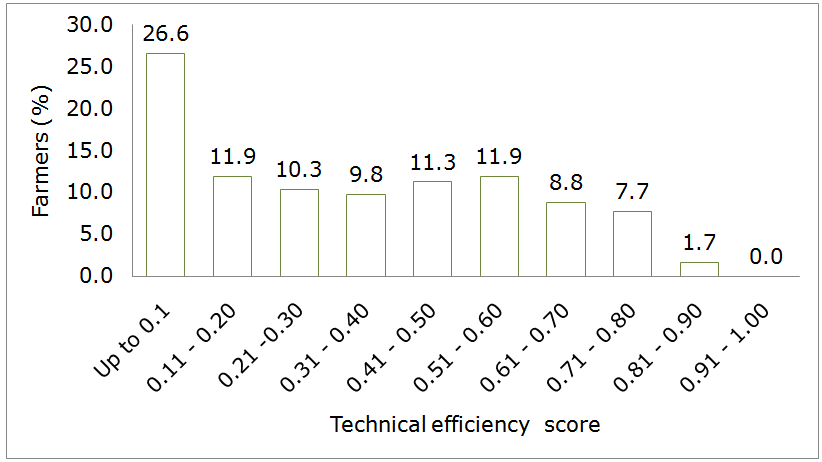 | Figure 5. Distribution of the technical efficiency |
|
5.3. Factors Influencing the Technical Efficiency
|
|
5.4. Elasticity of the Technical Efficiency
- The estimated coefficients in the TLPF (Table 6) do not have a straightforward interpretation. It was necessary to estimate the output elasticity for each of the inputs used in order to have a meaningful interpretation[21, 36]. Equation 11, 12 and 13 below are used to estimate the elasticity of the output with respect to the farm size (FS), family labour (FL) and the expenditure on hired labour (CP). In these equations, coefficients and mean values of the respective inputs are used to estimate the elasticity.
|
 | (11) |
 | (12) |
 | (13) |
|
6. Conclusions
- The technical efficiency indicates that the crop productivity in the study area is low. Farmers do not have means of investing on land in order to improve crop production. This has resulted to the majority of the farmers to rely on additional land for cultivation in order to compensate for the declined crop harvest through farming on forested areas considered to be rich in natural crop yields. The production in the study area is operating at decreasing return to scale. This implies that additional application of the current inputs would, in relative terms; result in a smaller increase in crop output. This suggests that, to improve crop production, there is a need of introducing other inputs in addition to those that are currently used. The income from crops is found to influence positively the welfare of households in the area. This implies that watershed resources have a greater role to play on the welfare of the communities because of the direct relationship between crop cultivation and the watershed environment. Therefore there is a need to take into account the sustainability of the watershed resources when setting development policy in the study area. The higher technical efficiency in crop production would enable households to harvest large quantity of crop output per unit area. This could limit the proportion of the agricultural land in the catchment. The cause of the inefficiency is therefore needed to be addressed in order to have sustainable watershed resources and the improved human welfare.
 Abstract
Abstract Reference
Reference Full-Text PDF
Full-Text PDF Full-text HTML
Full-text HTML